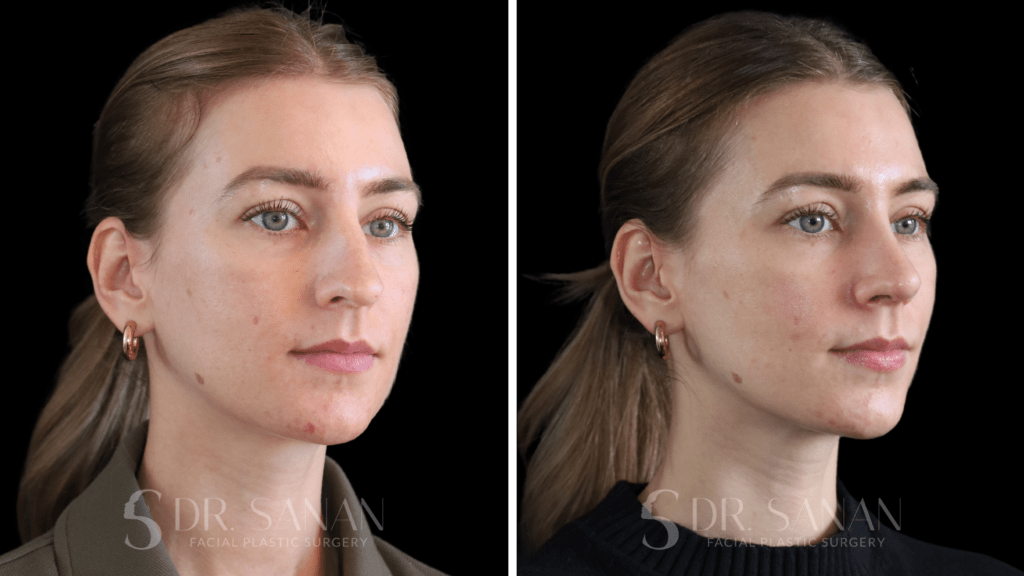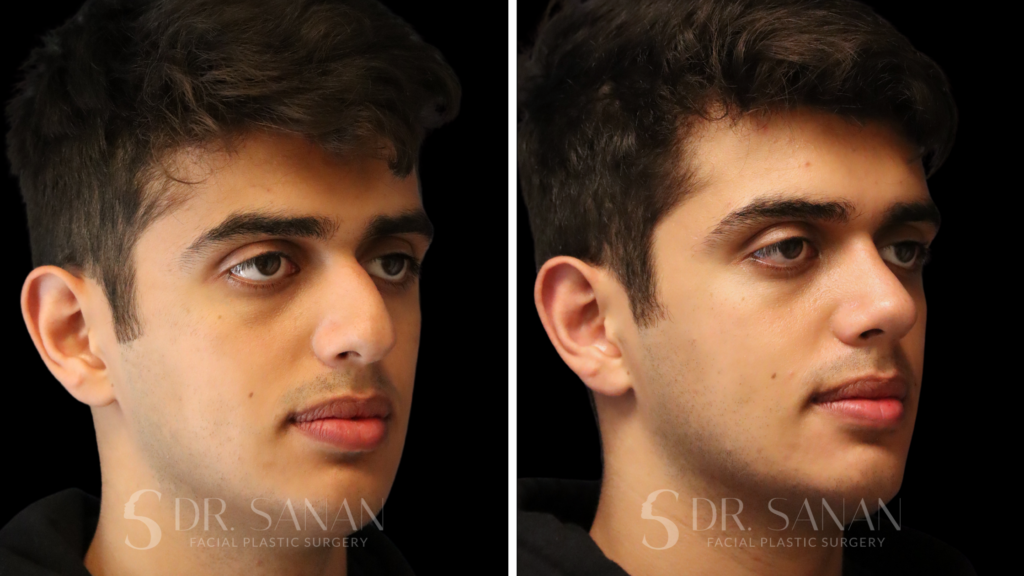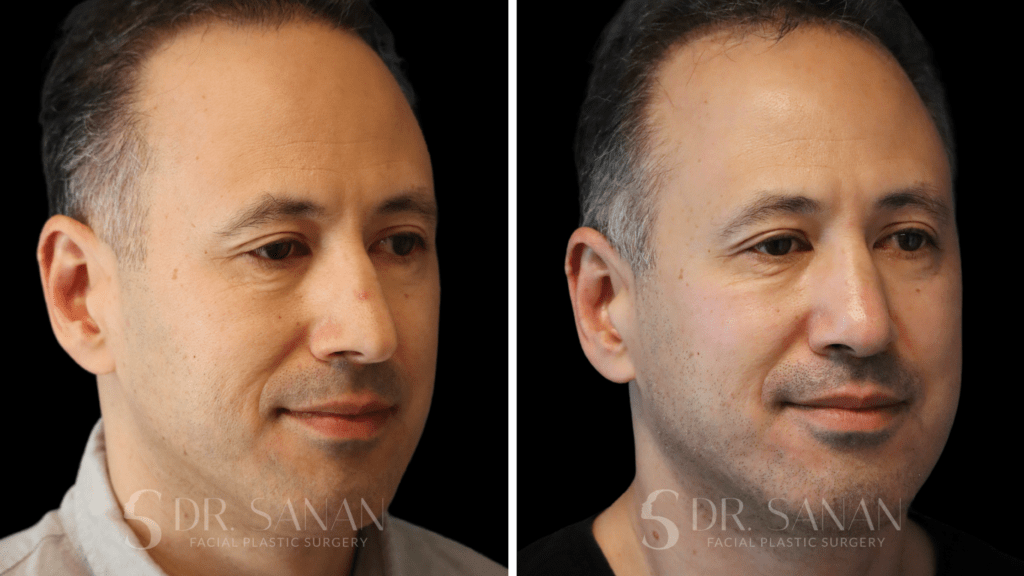Nose Job Recovery Time: What to Expect After a Rhinoplasty in Boston, MA
If you’re considering rhinoplasty, often referred to as a nose job, understanding the recovery process is crucial for achieving the best results. Rhinoplasty is a transformative procedure that reshapes the nose to enhance facial harmony and improve function, but the journey doesn’t end after the surgery. Recovery is a vital phase, and knowing what to expect can help you navigate it with confidence. Dr. Akshay Sanan, a double board-certified facial plastic surgeon in Boston, MA, combines advanced surgical techniques with personalized care to ensure his patients experience a seamless recovery process and achieve their desired outcomes.
The Comprehensive Benefits of Rhinoplasty
Rhinoplasty, commonly known as a nose job, is a transformative procedure that goes beyond simply altering the appearance of the nose. It provides a range of both aesthetic and functional benefits, making it one of the most versatile and impactful facial surgeries available. Whether you’re seeking cosmetic refinement or addressing a medical concern, rhinoplasty offers life-changing outcomes.
Improved Facial Harmony
The nose is a central feature of the face, playing a significant role in overall facial balance and symmetry. Rhinoplasty can reshape the nose to better complement your other features, whether by refining the nasal tip, reducing a dorsal hump, or adjusting the nostril size. A well-proportioned nose can enhance the harmony between the eyes, cheeks, lips, and chin, creating a more cohesive and attractive appearance. Dr. Akshay Sanan’s expertise in facial aesthetics ensures that each adjustment is carefully planned to achieve a natural look that aligns with your unique facial structure.
Enhanced Breathing
Beyond aesthetics, rhinoplasty also has critical functional benefits. Functional rhinoplasty addresses structural issues within the nasal passages, such as a deviated septum, enlarged turbinates, or collapsed nasal valves, which can impede airflow. By correcting these problems, rhinoplasty improves breathing, reducing issues like chronic congestion, snoring, or difficulty exercising. Improved nasal function enhances not only physical health but also overall quality of life, allowing patients to breathe easily and comfortably.
Increased Confidence
For many patients, the emotional benefits of rhinoplasty are as significant as the physical improvements. Whether correcting a cosmetic concern, such as a bump on the bridge of the nose or resolving a functional issue, rhinoplasty can dramatically boost self-esteem and body image. Feeling confident in your appearance often translates to greater self-assurance in personal and professional interactions. Dr. Sanan understands the profound impact this procedure can have on his patients’ lives and takes great care to ensure that each outcome meets their expectations and goals.
Dr. Sanan’s Meticulous Approach to Rhinoplasty
Dr. Akshay Sanan, a double-board-certified facial plastic surgeon in Boston, MA, is renowned for his precision and dedication to achieving exceptional results. His approach begins with a comprehensive evaluation of each patient’s anatomy, facial proportions, and aesthetic goals. Dr. Sanan takes the time to listen to his patients’ concerns, understanding their desires for both form and function.
Using advanced surgical techniques, Dr. Sanan tailors each rhinoplasty to the individual, ensuring that the results not only improve the nose’s appearance but also enhance overall facial balance and maintain functionality. His meticulous attention to detail includes precise incisions, careful adjustments to cartilage and bone, and thorough postoperative care to optimize healing and results. This commitment to excellence ensures that every rhinoplasty delivers outcomes that are natural, balanced, and beautifully aligned with the patient’s unique features.
Whether you’re seeking to refine your nose’s appearance, improve breathing, or achieve both, Dr. Sanan’s expertise ensures that rhinoplasty can be a transformative and rewarding experience.
The First Two Weeks of Rhinoplasty Recovery: A Day-by-Day Breakdown
Day 1: Surgery Day
On the day of your rhinoplasty, you’ll likely feel groggy as the effects of anesthesia wear off. To protect the new structure of your nose, a splint or cast will be applied, and a small drip pad may be placed under your nose to catch any mild bleeding, which is normal during the first 24 hours. Although pain is typically mild due to the lingering anesthesia, it is less of a pain and more of a sinus headache comparable to being stuffed up.
- Pain Level: Mild to moderate, manageable with prescribed medication.
- Activity: Strict bed rest; avoid movements or activities that could strain your nose.
Days 2–3: Peak Swelling and Discomfort
Swelling and bruising around your nose and eyes will peak during this time, accompanied by a sensation of pressure in your nasal passages. Saline rinses can help alleviate some congestion, while prescribed medications manage discomfort effectively. This phase can feel the most challenging, but it’s important to rest and stay patient as your body begins to heal.
- Pain Level: Moderate, controlled with medication.
- Activity: Rest is crucial; light walking is beneficial for circulation but avoid strenuous activities.
Days 4–5: Swelling Begins to Subside
As you approach the middle of the first week, you’ll notice a gradual reduction in swelling and bruising. Breathing through your nose may still be difficult, but residual bleeding typically subsides by this point.
- Pain Level: Mild to moderate, improving daily.
- Activity: Light walking is fine, but avoid bending over, heavy lifting, or any activity that increases blood pressure.
Days 6–7: Splint Removal
This marks an exciting milestone in your recovery as Dr. Akshay Sanan will remove your splint, allowing you to see your nose for the first time post-surgery. Keep in mind that swelling will still obscure the final results. You may feel tightness or stuffiness, but breathing should begin to improve gradually.
- Pain Level: Minimal, though tenderness may persist.
- Activity: Gentle face washing is permitted, but avoid applying pressure to your nose.
Days 8–10: Significant Improvement
By the second week, swelling and bruising will have significantly decreased, and you’ll likely feel more comfortable. Although your nose may still be tender and slightly swollen, most patients can resume light daily activities.
- Pain Level: Minimal.
- Activity: Resume light tasks, but avoid strenuous activities or anything that puts strain on your nose.
Days 11–14: Returning to Routine
By the end of the second week, most patients feel ready to return to work or school, provided their activities aren’t physically demanding. Any visible bruising will have faded considerably, and you’ll begin to feel more like yourself. However, some swelling may still linger.
- Pain Level: Almost none.
- Activity: Light activities are fine, but avoid exercise or heavy lifting for another week or two.
Rhinoplasty Recovery Over the First Year
One Month Post-Surgery
By the four-week mark, the majority of noticeable swelling will have subsided, allowing you to engage in regular activities with ease. Internal swelling will continue to decrease, making breathing easier. While early results are visible, the final shape of your nose will take more time to emerge.
- Pain Level: None.
- Activity: Normal activities and light exercise are fine, but avoid contact sports or activities that could impact your nose.
Three Months Post-Surgery
At three months, approximately 90% of the swelling will have resolved. Your nose will feel more natural, and breathing should be fully restored. Residual swelling, especially at the nasal tip, may still be present but will continue to diminish over time.
- Pain Level: None.
- Activity: All regular activities, including contact sports, with your surgeon’s approval.
Six Months Post-Surgery
By six months, any remaining swelling will be minimal, and the tip of your nose will soften further. At this stage, most patients are thrilled with their results, though final refinements may still occur. Dr. Sanan will continue to monitor your progress to ensure optimal outcomes.
One Year Post-Surgery
By the one-year mark, your rhinoplasty will be fully healed, and the final results will be visible. The shape and size of your nose will have settled, blending seamlessly with your other facial features for a natural and harmonious look.
Common Questions About Rhinoplasty Recovery
How Much Pain Should I Expect After a Nose Job?
Pain is typically mild to moderate and easily managed with prescribed medications. Most patients report congestion and pressure as the primary sources of discomfort rather than significant pain.
When Can I Return to Work?
Most patients feel ready to return to work within 10–14 days, depending on the nature of their job. Physically demanding jobs may require additional recovery time.
How Long Will My Nose Be Swollen?
Visible swelling decreases significantly within the first month, but subtle swelling, especially at the nasal tip, can persist for several months. Full resolution takes up to a year.
When Can I Exercise Again?
Light activities, such as walking, can resume within a few days. Strenuous exercise should be avoided for at least three to four weeks, and contact sports require clearance from your surgeon.
Schedule Your Consultation with Dr. Akshay Sanan in Boston, MA
Recovering from rhinoplasty requires patience and adherence to your surgeon’s guidelines, but the results are worth the effort. With Dr. Akshay Sanan’s expertise, meticulous attention to detail, and commitment to personalized care, you can feel confident about achieving your desired results. Schedule a consultation with Dr. Sanan in Boston, MA, to take the first step toward the nose you’ve always envisioned.






